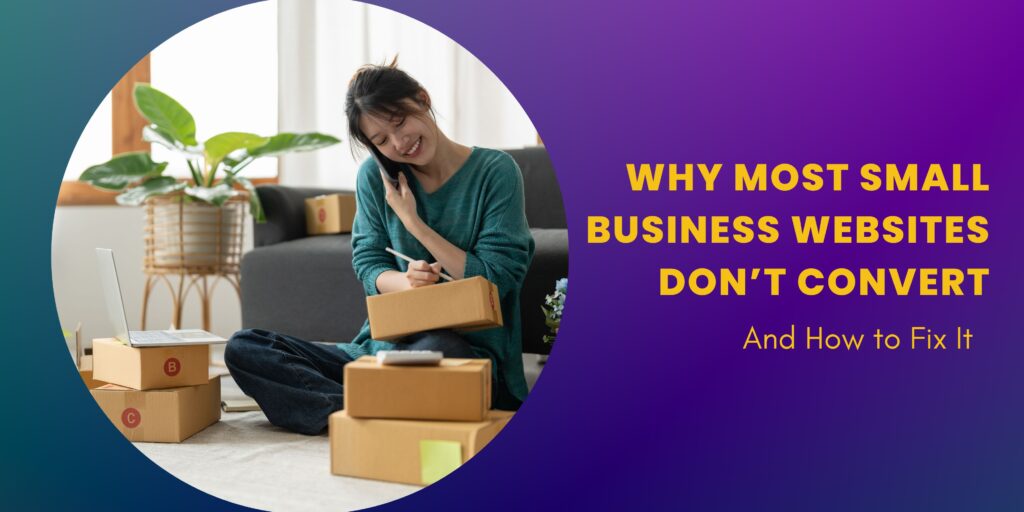Hi, I’m Chijindu, a small business owner like you, navigating the sometimes confusing world of visibility. One challenge I face in my website design service is figuring out how to create small business websites that truly attract, not just visitors, but the right audience for my clients.
To get this right, I began researching and testing what makes some websites perform better than others. What I discovered is simple yet powerful:
A great website, beyond looking beautiful, should help you sell or promote your product or service. Unfortunately, most small business owners miss this. Their websites look sleek and modern, but fail to convert.
In this article, I’ll show you exactly why most small business websites don’t convert and how you can fix yours today.
1. The Website Looks Great, but Says Nothing Clearly
Ever landed on a website and couldn’t tell what the business actually does?
That’s a conversion killer!
One client I worked with used high-sounding, technical language to describe his services. The words sounded “big” but were vague. Humans can’t relate, and search engines can’t index them properly.
I rewrote the website copy in simpler, clearer language that spoke directly to customers, but he preferred the high-sounding version.
That decision cost him visibility.
Here’s the truth:
According to a Stanford University study, 75% of users judge a company’s credibility based on its website design and clarity.
When your message is confusing, visitors click away. So before worrying about animations or fancy fonts, make sure your core message is crystal clear in the first few seconds.
Here’s what I mean: can you guess what this business actually does?

After browsing through the products on the website, I finally pieced together what this business is about. If I were to rewrite the homepage copy so humans, AI, and search engines all get it instantly, it would sound something like this:
Empowering Businesses with Smart,
Scalable Software Solutions
From business management to supply chain, from accounting to HR & people management, we build powerful cloud-based tools that simplify workflows, improve efficiency, and accelerate growth.
Personally, I think the second version strikes the right balance. It’s professional and clearly communicates what the business does at a glance. But hey, I’d love to hear your thoughts in the comments!
2. Too Much Going On
Many small business websites are overcrowded, with too many tabs, buttons, images, and moving text.
This “everything everywhere” approach overwhelms visitors.
A study found that 38.5% of users leave a website if the design or layout is unattractive. But “unattractive” isn’t just about looks, it’s about clutter and confusion.
Here’s how to fix this:
- Keep your navigation simple.
- Use one main call-to-action per page.
- Let white space breathe.
The goal is to guide, not confuse.
3. The Design Is Pretty, But Doesn’t Sell
It’s easy to get carried away with colors, fonts, and animations. But remember: A beautiful website that doesn’t sell is just an expensive brochure.
Your design should lead visitors toward action, not just admiration. That means having clear CTAs like “Book a Consultation,” “Order Now,” or “Get a Free Quote.”
Each visual element should serve a purpose, to make it easier for your audience to say yes.
4. There’s No Emotional Connection
People buy from people they trust. Your website should tell a story that helps visitors feel understood and supported.
Explain what problem you solve and why it matters.
You can use a structure like this:
“We know you want to be [desired identity].
But [problem] makes that hard.
That’s why we created [solution].”
For example:
We know you want to ace your courses. But college is pretty hard. That’s why we created StudyBuddy, a program that simplifies your courses and helps you study with ease.
This helps potential customers see themselves in your story.
5. Missing the Trust Builders
Testimonials, reviews, and client logos are not just nice extras, they help build credibility. According to BrightLocal’s research, 87% of consumers read online reviews for local businesses before making a decision.
When visitors see proof that others trust you, they’re more likely to patronize you. So, if you already have this proof, why not use it to your advantage!
6. No Clear Plan or Process
Confusion kills conversion. If people can’t see how your process works, they won’t act.
Create a short, visual guide like:
- Book a call
- Approve your design
- Go live
This makes your offer feel easy and attainable.
7. No Lead Magnet or Follow-Up Strategy
Some visitors may not be ready to buy right away and that’s okay.
But you can still keep the conversation going.
Offer a lead magnet like a free checklist, guide, or resource in exchange for their email. It helps you build a mailing list for future follow-up and increases your chances of conversion over time.
8. Weak or Missing Call to Action
You’d be surprised how many small business websites have no clear next step.
If visitors don’t know what to do next, they’ll simply leave.
End every page with a strong CTA like:
- “Get Started Today”
- “Schedule Your Free Consultation”
- “Download Your Free Guide”
It should feel natural, direct, and valuable.
Final Thoughts
A website should do more than exists, it should convert.
The key is to blend clarity, simplicity, and strategy into every section of your site.
When visitors instantly understand what you offer, how it helps them, and what to do next, you’ve built a site that sells.
Ready to Turn Your Website into a Sales Machine?
If your current website isn’t bringing the results you want, it’s time for a strategic redesign.
Let’s work together to create a website that looks good and works hard to grow your business.

